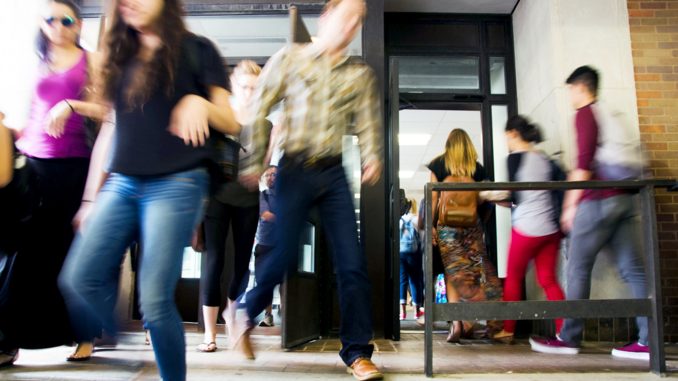
Almost a year after a professor was robbed in his Anderson Hall office, new security measures in the building have exacerbated a pre-existing crowding issue.
At peak hours between classes, as many as 200 students enter and exit the building and its classrooms at once. With small hallways and ID checks at chokepoints, a bottleneck is created at the main entry and exit points of Anderson.
The robbery which spurred the new security occurred on Oct. 29, 2013, when Darryl Moon entered Anderson and went up to the Intellectual Heritage offices on the second floor. He assaulted an 81-year-old professor and took his wallet.
The professor suffered lacerations to his face and head in addition to swelling and bleeding in his brain.
A security camera caught Moon leaving Anderson through the second floor mezzanine doors. This weekend, Moon was sentenced to 17-35 years in prison after pleading guilty to aggravated assault and robbery charges in June.
In March, the Board of Trustees approved a $300,000 increase in security spending for academic buildings in response to the October robbery.
Executive Director of Campus Safety Services Charlie Leone said security was improved by adding alarms and sealing all “convenience doors” over the summer. Leone categorized convenience doors as doors not on the first floor of Anderson Hall, where AlliedBarton security officers monitor traffic.
The second floor mezzanine doors — through which the perpetrator of the October robbery is suspected to have entered the building — are among the doors now sealed from students exiting, outside of an emergency.
Leone recalled a separate incident last year when a man with a criminal record entered Anderson through those doors wearing stolen attire from Temple’s dental school.
“He was let in by an unknowing student,” Leone said. “He then stole things from the upper floors.”
Temple Police apprehended the suspect the next day, Leone said.
He said students frequently exited from the mezzanine doors, reducing traffic at the entrance and exit on the first floor.
Jim Creedon, senior vice president for construction, facilities and operations, told The Temple News in an email that those mezzanine doors allowed “non-authorized individuals to enter and avoid security.”
An AlliedBarton security guard, who wished to remain anonymous since he was not authorized to speak to the media, said that he “didn’t know about these changes.”
The man has worked at Temple for seven years and said he has “never seen the building so busy.”
Leone said that this semester the AlliedBarton district manager moved to the Temple Police headquarters.
“I felt with the growth of the university and adding many more resources from AlliedBarton, we needed representation in our headquarters for improved communication and collaboration,” Leone wrote in a follow-up email.
Sophomore and actuarial science major Kelly Petrarca said crowding “reaches a climax in between classes when there are too many students in too small hallways.”
“With only 10 minutes between my classes across campus, I don’t have the time to spare,” Petrarca added.
Leone said Anderson was designed for holding offices, not classrooms.
The structure of the building is not capable of handling such large amounts of students, he said. The building’s elevators “can barely keep up with their demand,” he added.
“The building was built in a time when security was not even a thought for an academic building,” Creedon said.
Creedon said one possible solution to the crowding problem is to move classes exclusively to the building’s lower floors. Currently, multiple classes are held on each of the building’s 12 floors throughout the entire day.
“That could open up some capacity and encourage students to use the steps more often,” Creedon said.
Both Creedon and Leone agree they are interested in a long-term solution to the dilemma. Leone said Temple is considering a long-term project involving a redesigned lobby with a larger entrance, more ID checkpoints or automatic swipe technology, which will be in the soon-to-be-opened SERC building.
“With the reality of what is required and expected today, some inconvenience will occur until we can construct a long term solution,” Creedon said.
In his conclusion, Leone said the “overall goal is always to improve security.”
Rachel Clark can be reached at rachaelclrk@temple.edu.
Joe Brandt contributed reporting.



The mezzanine door are open, and used frequently. Personally, I like this, but to claim they are locked and emergency exit only is laughable.